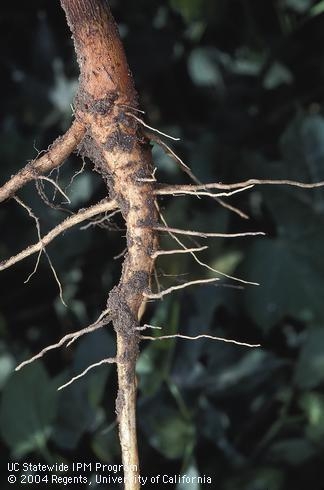I attended an informative conference in October that reported on the latest research results on tree root development in urban soils- the Landscape Below Ground. This was the fourth conference on this subject in the last 25 years. Much of the research seemed to confirm findings I had previously read and which have mostly been incorporated into recommendations and practice, at least in the state of California. However, it is always good to have research repeated and confirmed in a variety of scenarios and species, and there were some new and interesting findings as well. I am going to recap some of both in the next couple of posts.
Pre-plant Tree Inspection ladder root system
ladder root system

The health of trees initially, especially the structure of their root system, has a significant impact on the survival rate and growth of trees after planting. Fall is an excellent time for planting trees, so pay attention to this if you are installing this season. The most important aspect of the root system (which you should inspect before planting) can be summed up in this phrase: straight roots, some of them near the surface. What trees need, and what you want is a "ladder" of roots, all of them straight or bending less than 45°. You don't want them all going straight down (diving), or the tree cannot stabilize itself in the ground. For all aspects of a healthy nursery tree, see this: Guidelines for Nursery Tree Quality.
At the nursery, a good root system can be accomplished best by one of two methods: potting up to the next size in a timely manner and shaving all roots to the point where they hit the edge at the time of potting up. This eliminates the bends before they set up in the next size. The second method is to use something called an air pot, which has perforations throughout the surface. When roots reach air, they die at the tip rather than continue to grow in a circular manner around the pot. Demand good stock and give your business to nurseries that provide it. The guidelines for growing quality trees can be found here: Quality Tree Production Strategies.
Soil Preparation
Whenever possible, rip or deep till and incorporate up to 25% organic matter to add carbon and air space for optimal root growth (more than 25% is not better). Shallow tillage has only very brief effects on trees, since roots ideally grow down past the initial 12" rather quickly. Roots grow where they can. Sounds obvious, but without oxygen and carbon dioxide exchange space, without water penetration, roots will not grow out into surrounding soil. Minimum root system means minimum canopy. If tilling cannot be done because of existing trees or other infrastructure, you can add some pore space by deep drilling holes 2' deep and 2" wide and filling with small gravel or biochar, which will maintain the space for oxygen and drainage. Additionally, sufficient space for tree roots should be planned in advance. If pavements must be installed over tree roots' eventual growth area, structural soils can significantly enhance the trees' ability to support healthy growth. To read about a project at UC Davis: UCD Parking Lot Structural Soil. For a complete guide to the first structural soil created by Cornell University researchers and to read research updates (scroll halfway down page): Urban Horticulture Institute.
Mulch
Do it. Time and again research confirms the benefits of organic mulches for improvement of soil structure, water infiltration, moisture retention, temperature buffering for root health, and the health of beneficial soil microbes. The results are still out on whether the source of the mulch makes a difference, and research is ongoing to find out if mimicking the native soil litter for a particular species is more beneficial than non-specific mulch from other species.
Next week we'll discuss Fertilizing, Disease, and Tree Stability.